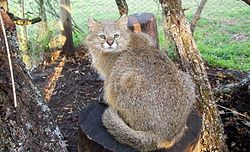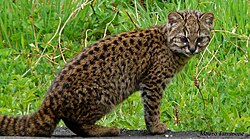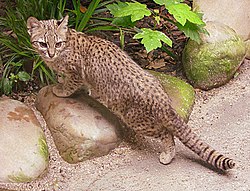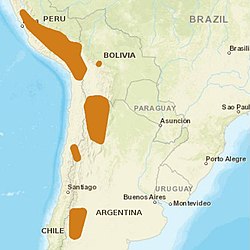| nuclear DNA: [4] |
|---|
| mitochondrial DNA: [37] | |||||||||||||||||||||||||||||||||||||||||||||||||||||||||
|---|---|---|---|---|---|---|---|---|---|---|---|---|---|---|---|---|---|---|---|---|---|---|---|---|---|---|---|---|---|---|---|---|---|---|---|---|---|---|---|---|---|---|---|---|---|---|---|---|---|---|---|---|---|---|---|---|---|
|
| Leopardus | |
|---|---|
 | |
| Leopardus species from top-left, clockwise: ocelot (L. pardalis), oncilla (L. tigrinus), Pampas cat (L. colocola), kodkod (L. guigna), margay (L. wiedii), Geoffroy's cat (L. geoffroyi) | |
| Scientific classification | |
| Kingdom: | Animalia |
| Phylum: | Chordata |
| Class: | Mammalia |
| Order: | Carnivora |
| Family: | Felidae |
| Subfamily: | Felinae |
| Genus: | Leopardus Gray, 1842 |
| Type species | |
| Leopardus griseus [2] Gray, 1842 | |
 | |
| Leopardus distribution | |
Leopardus is a genus comprising eight species of small cats native to the Americas. [3] This genus is considered the oldest branch of a genetic lineage of small cats in the Americas whose common ancestor crossed the Bering land bridge from Asia to North America in the late Miocene. [4]
Leopardus species have spotted fur, with ground colors ranging from pale buff, ochre, fulvous and tawny to light gray. [5] Their small ears are rounded and white-spotted; their rhinarium is prominent and naked above, and their nostrils are widely separated. [6] They have 36 chromosomes, whereas other felids have 38. [7]
The generic name Leopardus was proposed by John Edward Gray in 1842, when he described two spotted cat skins from Central America and two from India in the collection of the Natural History Museum, London. [8] Several genera were proposed in the 19th and early 20th centuries for small spotted cats in the Americas, including:
Analysis of skull morphology of these taxa revealed close similarities in their base of skulls and nasal bones, their masticatory muscles, and dentition. [14] Phylogenetic analysis of tissue samples of these taxa and their ability to hybridise support the notion that they are members of the same genus. [4] [7] The following eight extant Leopardus species have commonly been recognized as valid taxa since 2017: [3]
| Name | IUCN Red List status and distribution |
|---|---|
Ocelot L. pardalis(Linnaeus, 1758) [15]  | LC [16]  |
Oncilla L. tigrinus(Schreber, 1775) [17]  | VU [18]  |
Pampas cat L. colocola(Molina, 1782) [19]  | NT [20]  Range includes multiple species |
Kodkod L. guigna(Molina, 1782) [19]  | VU [21]  |
Margay L. wiedii(Schinz, 1821) [22]  | NT [23]  |
Geoffroy's cat L. geoffroyi(d'Orbigny & Gervais, 1844) [24]  | LC [25]  |
Andean mountain cat L. jacobita(Cornalia, 1865) [26]  | EN [27]  |
Southern tigrina L. guttulus(Hensel, 1872) [28]  | VU [29]  |
Additionally, more recent genetic analyses in 2017 and 2021 proposed the recognition of a third tigrina-like species, Leopardus emiliae . [30] [31]
A 2021 analysis of 142 pampas cat museum specimen collected across South America showed significant morphological differences between them. Therefore, it was proposed to split the historically-contentious pampas cat species complex into five species: Leopardus colocolo, Leopardus braccatus , Leopardus garleppi , Leopardus munoai, and Leopardus pajeros . [32] Later that same year, it was noted that the oldest available name for pampas cats of the Uruguayan savannah region was Leopardus fasciatus , not L. munoai. [33]
Another study in 2023 described another new species, Leopardus narinensis , based on a single dried skin collected in 1989 on the Galeras Volcano in the Nariño Department of Colombia. They found it to be very different from all other Leopardus species both morphologically and genetically. [34]
A different study in 2024 did a detailed analysis of both the morphology and genetics of specimens assigned to Leopardus tigrinus, Leopardus guttulus, and Leopardus emiliae. It suggested L. t. pardinoides should be elevated to species status as Leopardus pardinoides due to significant differences in morphology, genetics, and ecology. The study also assigned the subspecies L. t. oncilla to be a subspecies of L. pardinoides as L. p. oncilla. Additionally, genetic analysis suggested that Leopardus emiliae was not genetically distinct from L. tigrinus, and thus may be invalid. The study recommended the common names savannah tiger-cat for L. tigrinus, Atlantic Forest tiger-cat for L. guttulus, and clouded tiger-cat for L. pardinoides. [35]
An expanded list of Leopardus species would be: [36]
Phylogenetic analysis of the nuclear DNA in tissue samples from all Felidae species revealed that the evolutionary radiation of the Felidae began in Asia in the Miocene around 14.45 to 8.38 million years ago. [4] Analysis of mitochondrial DNA of all Felidae species indicates a radiation at around 16.76 to 6.46 million years ago. [37]
The last common ancestor of Leopardus, Puma and Lynx is estimated to have lived 10.95 to 6.3 million years ago, based on analysis of nuclear DNA of cat species. [4] Analysis of their mitochondrial DNA indicates that their last common ancestor lived 14.04 to 6.83 million years ago. [37] Leopardus forms an evolutionary lineage that genetically diverged between 4.25 to 2.02 million years ago [4] and 5.19 to 0.98 million years ago. [37] It crossed the Isthmus of Panama probably during the Great American Biotic Interchange in the late Pliocene. [4] Leopardus vorohuensis is an extinct species of the genus, of which fossils were found in the Argentinian Vorohué Formation dated to the early Pleistocene; its supraorbital foramen and shape of teeth resemble those of the pampas cat. [1]
Within the genus, three distinct clades were identified: one comprising the ocelot and the margay, a second the Andean mountain cat and Pampas cat, and the third the kodkod, oncilla and Geoffroy's cat. [38] [39] The following cladogram shows estimated divergence times in million years ago (mya).
| nuclear DNA: [4] |
|---|
| mitochondrial DNA: [37] | |||||||||||||||||||||||||||||||||||||||||||||||||||||||||
|---|---|---|---|---|---|---|---|---|---|---|---|---|---|---|---|---|---|---|---|---|---|---|---|---|---|---|---|---|---|---|---|---|---|---|---|---|---|---|---|---|---|---|---|---|---|---|---|---|---|---|---|---|---|---|---|---|---|
|